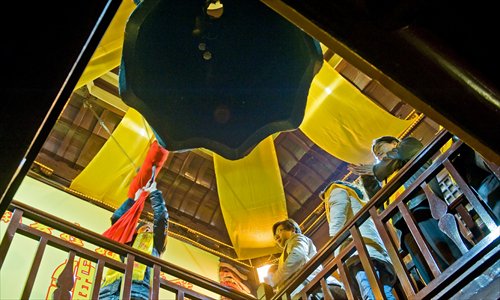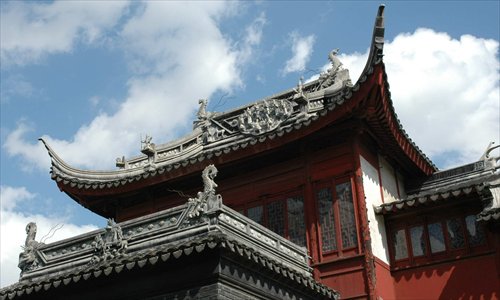HOME >> METRO SHANGHAI, LIFE
Forgotten delights
By Yang Zhenqi Source:Global Times Published: 2014-4-22 19:08:01

The Longhua Temple's bells are struck on Chinese New Year. Photo: CFP
Most Shanghai residents are now well aware of the eight sightseeing spots chosen by the city's tourism bureau in 2009 and trumpeted constantly ever since. But few residents or visitors know about the eight ancient sightseeing wonders of Shanghai, a list whose origins can be traced back to the early Qing Dynasty (1644-1911) when Shanghai was nothing but a humble fishing village.
The modern attractions are: the Bund, Yuyuan Garden, Nanjing Road East Shopping Street, the Shikumen (stone-gate lane houses) Exhibition, the Lujiazui Financial Zone, Fengjing Old Town in Jinshan district, Sheshan Mountain in Songjiang district, and Dianshan Lake in Qingpu district.
While some of these are natural haunts, most have been created within the past 180 years of the city's life. The ancient scenic highlights originally appeared in the works of Shanghai native Li Xingnan, a poet who lived during the reign of the Qing Emperor Qianlong.
These eight sites - most of which no longer exist today - are a reminder of the city's amazing geographical and social transformation. The Global Times checked out the Eight Great Attractions of Ancient Shanghai.
Haitian Xuri is a phrase coined in the Shanghai region during the Ming (1368-1644) and Qing dynasties. It describes the way the sun rose against a backdrop of breathtaking seascapes. The region's zigzag coastline was home to massive natural marshlands and birdlife and offered a stirring view of the sun emerging from the East China Sea.
Huangpu Qiutao records an ancient tradition where people in the Shanghai region gathered to see the tidal bores at Lujiazui, a mouth-like estuary on the eastern side of the Huangpu River, during the eighth month of the Chinese lunar calendar. Every autumn the spectacular tides flowed along the river and attracted crowds. The best place in Shanghai to see this was from Guantao Lou, a tall building located in the southwest of today's Yuyuan Garden. These days thousands of onlookers gather to watch the tidal bore on the Qiantang River near Hangzhou Bay in Zhejiang Province.
Wusong Yanyu is a poetic expression picturing the misty scenery of Wusongkou, a port in today's Baoshan district. It was said the Shanghai rainfall created a foggy and filmy backdrop where the sea met the sky and ships and boats sailed gracefully along the river. The river referred to was the Wusong River, better known today as Suzhou Creek.
Shiliang Yeyue was all the fashion around Shanghai in the Qing Dynasty when local people went to a special stone bridge, Lujiaqiao, to delight in the image of the moon reflected on the water on the evening of the Mid-Autumn Festival. The inverted image was said to be a refined contrast to the full moon in the sky, and attracted huge crowds. The bridge, named after its creator, a government official surnamed Lu of the Ming Dynasty, was a grand piece of architecture of that era but it was later knocked down for road construction. It was sited in the Xiaodongmen area, near the City God Temple in downtown Huangpu district.
Yedu Jianjia described the idyllic boating, fishing and sightseeing to be enjoyed on the outskirts of the Shanghai region. With villages scattered around the region's outer areas, there was plenty of fun for locals to indulge in. It's not the same today as those villages have become high-rise developments in their own right, but some areas try to offer a taste of the ancient delights with tourism events, and traditional fishing, farming and boating activities for visitors.

The preserved part of Dajingge, where locals drank wine and enjoy the snowscapes. Photo: CFP
Jianggao Jixue describes the scene where, in winter, Shanghai people climbed the Dajingge tower to drink wine and admire the snowscapes. The Dajingge tower can be traced back to the Ming Dynasty but over the years it was renovated and altered. During the reign of the Qing Emperor Jiaqing it was enlarged and became a three-story tower along the city walls. Standing on the top floor gave a great view of the city in winter. Nestled on today's Dajing Road, beside People's Square, Dajingge went through another major facelift in 1992 and has now reopened as a historic tourism attraction (pictured below). A 50-meter section of the old stone city wall was also preserved in the 1992 renovation project.
Fenglou Yuantiao is another phrase that marked the way Shanghai people climbed to enjoy a view of two of the most important festivals in their calendar -the Double Ninth, or Chongyang, and the Dragon Boat Festival, or Duanwu. People climbed a tower, Danfenglou, in the Shunji Temple that was built in the Southern Song Dynasty (1127-1279). During the Ming Dynav sty the tower was moved to its current location, near today's City God Temple, and was said to be the best spot to watch dragon boat racing on the Huangpu River during Duanwu. The tower has gone and the site is now a public park.
Longhua Wanzhong is another attraction that can still be enjoyed in modern Shanghai. The phrase pictures the bustling scenes at the Longhua Temple on every 15th day of the third month of the Chinese lunar calendar when the temple fair attracted hundreds of thousands of Buddhists to burn incense, listen to the bells and pray for good health and fortune. Located in today's Xuhui district, the Longhua Temple dates back to the Three Kingdoms period (220-280). In 1894, during the reign of Qing Emperor Guangxu, the temple added a 2-meter-high, 6,500-kilogram bronze bell. Instead of being struck in the middle of the third lunar month as had been the tradition, this bell was rung 108 times on the eve of the Chinese New Year. This annual event still attracts thousands from throughout China and abroad. Anyone who hears the 108 bell strikes is said to be blessed for the following year.
Posted in: Metro Shanghai